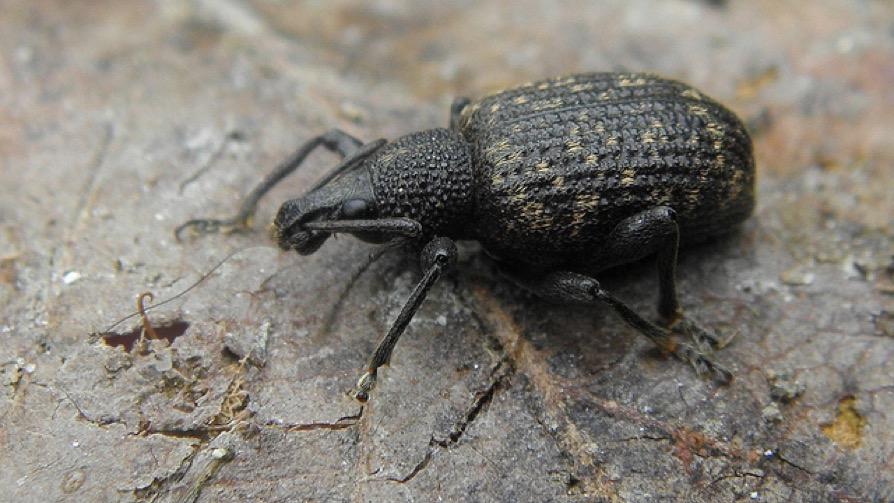Key points
- The two-banded Japanese weevil and the black vine weevil are two species of flightless weevils which feed as adults by notching leaves and whose immature forms, called grubs, feed on roots.
- Infestations spread slowly from one area to another since adults do not fly. However, once a plant is infested, the population on that plant may increase rapidly.
- When feeding adults are disturbed they will drop to the ground and feign death. To determine if the weevils are active, hold a piece of cardboard under the shrub and shake it to see if any adult weevils drop on to it.
Plants attacked
- These weevils are pests of over 100 plants, ranging from weeds to shrubs to greenhouse plants. Some of the common host plants in Maryland include azalea, holly, strawberry, rhododendron, yew, and grape.
Damage

- When weevils are present in low numbers only a few notches on the edges of leaves will be apparent. If many weevils are present, the leaves are often scalloped and left with only the main vein.
- The grubs are highly destructive to plants. When small, grubs consume feeder roots. Larger grubs feed on larger roots, stripping the bark and sometimes girdling the plant crown. This blocks the flow of water and nutrients to the foliage.
- Infested plants have stunted growth; leaves turn yellow and then wilt.
Life cycle
- Both weevil species have similar life cycles. In Maryland, adults emerge during mid-June.
- All adults are females, able to produce without mating. A newly emerged adult requires four to six weeks of feeding before her eggs develop.
- Five hundred or more eggs are laid, usually beneath or near the host plant.
- Feeding and egg laying continues until fall.
- Eggs hatch in 10 to 14 days.
- Newly hatched grubs are legless, C-shaped and off-white in color, with light brown heads.
- Young grubs tunnel underground and begin feeding on plant rootlets.
- Grubs feed all summer and into the fall before moving below the frost line for the winter.
Grubs resume feeding and produce the greatest amount of root damage in the spring. (A small percentage of adults may overwinter and begin feeding and egg laying much earlier. Therefore, grubs of two different sizes are sometimes found in the soil at the same time.) By late May, grubs have transformed into a resting stage called the pupa. Adults emerge from the soil about two weeks later.
Two-Banded Japanese Weevil

Two-banded Japanese weevils. Photo: John A. Davidson, University of Maryland, Bugwood.org
The two-banded Japanese weevil is about 1/4 inch long with a rounded abdomen and short snout. They are frequently overlooked because their brown subdued coloration allows them to blend in with the vegetation. Two mottled bands are distinguishable across the back. Adults are active during the daytime and can be found in branch crotches or clinging to twigs and foliage. They deposit eggs in inconspicuous folds of leaf fragments, primarily in litter around the base of the host plant.
Most of the adult damage occurs close to the ground, usually on new and inner foliage. Defoliation becomes more evident by late summer as the growth rate of the plant slows down and the effect of continuous adult feeding accumulates. Heavily infested plants may suffer complete defoliation.
Black Vine Weevil

Black vine weevil. Photo: Whitney Cranshaw, Colorado State University, Bugwood.org
Black vine weevils are about 3/4 inch long, oval and dull black in color. (See photo at top of page.) Adults feed only at night, hiding in debris and loose soil under plants during the day. They seem to prefer feeding on rhododendron, hemlock, and yew (or Taxus), hence the nickname 'Taxus Weevil'. Adult feeding may detract from the appearance of the plant but usually does not cause significant injury.
With the onset of egg laying, adult wandering increases. Eggs usually drop to the ground as the adult feeds. Serious damage results when numerous grubs feed on roots. Young plants can be killed by just a few grubs, while mature plants can tolerate a high grub population with little or no visible effect -- yet often die when transplanted.
Management
Control adults when leaf notching is abundant on new growth. Depending on local conditions, this could be from late May to mid-June. A registered insecticide may be used according to label directions.
